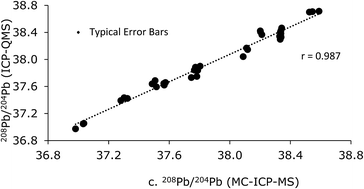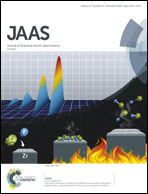Optimisation of a current generation ICP-QMS and benchmarking against MC-ICP-MS spectrometry for the determination of lead isotope ratios in environmental samples†
Abstract
Novel ANOVA methodology was used to benchmark ICP-QMS against MC-ICP-MS for Pb isotope ratios, demonstrating “fitness-for-purpose” in environmental source apportionment. The precision and accuracy of lead (Pb) isotope measurements obtained from quadrupole-based mass spectrometers (ICP-QMS) are considered to be limited by a number of factors originating in different components of the instruments. In this study, experimental and instrumental protocols were optimised for determining lead isotope ratios in urban soil digests. Experimental measures included individual dilution of all samples and isotopic standards (SRM-981, NIST) to a single Pb concentration intended to produce an intensity which was high enough to negate blanks and interferences but low enough to ensure the detector operated only in pulse counting mode. Instrumental protocols included batch dead time correction, optimisation of dwell time and the number of scans employed and correction of mass discrimination by sequential application of both internal (203Tl/205Tl ratio) and external (SRM-981, NIST) standards. This optimised methodology was benchmarked against multi-collector mass spectrometer (MC-ICP-MS) measurements of Pb isotope ratios using replicate digest solutions of the same soil; but after these had been subjected to Pb separation using an ion-exchange procedure. On the assumption that MC-ICP-MS measurements are more accurate, small additive and multiplicative differences were observed in only the 4th decimal place. ANOVA was used to compare the precisions of the two techniques demonstrating equal precisions c. 0.08% for 207Pb/206Pb, suggesting a sample heterogeneity limitation. By contrast, for 207Pb/204Pb, the worst-case ratio, ICP-QMS had a 10-fold poorer precision, despite negligible interference from 204Hg, implying an instrumental limitation. The study concludes that ICP-QMS can provide valuable source apportionment information for most Pb isotope ratios but further efforts should focus on improving assay of the 207Pb/204Pb ratio.



 Please wait while we load your content...
Please wait while we load your content...